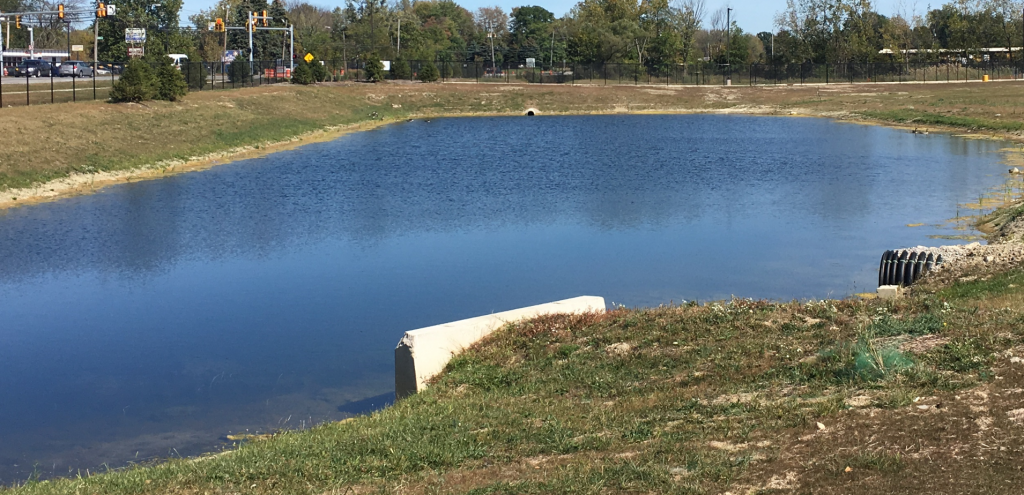
A key consideration for a civil engineer during site design from both a regulatory and cost standpoint is stormwater management. On the regulatory side, in recent years, agencies such as the Environmental Protection Agency (EPA) and, locally, the Northeast Ohio Regional Sewer District (NEORSD) have been encouraging property owners and engineers to provide infiltration methods on-site, rather than directing stormwater into detention basins that ultimately discharge to storm sewers or streams. This standard can be achieved through, amongst others, the following practices:
- Permeable Pavement – Permeable, or pervious, pavement allows water to infiltrate into the ground directly in small openings. This type of pavement can be asphalt or concrete, though the most common form is pavers. The gap between pavers is filled with small stones that allow stormwater to penetrate below. In large rain events, water that cannot be absorbed into the ground is conveyed to a storm sewer. While permeable pavement costs more up front than traditional asphalt or concrete, additional stormwater measures may be smaller or unnecessary depending on the site. It also yields long-term savings in stormwater fee credits (see below) because regulatory agencies consider permeable pavement similar to grass.
- Bioretention Cells – A bioretention cell is a stormwater management practice that consists of a depression that allows shallow ponding of stormwater runoff. The stormwater gradually percolates into the soil, mulch and vegetation, ultimately infiltrating into the ground — or in larger rain events, into a storm sewer. Bioretention cells are also an effective treatment option for water quality because they promote absorption and microbial breakdown by plants.
- Landscape Architecture – The landscape architecture of a site can incorporate many other elements that assist with stormwater management. These include constructed wetlands, rock infiltration trenches, and the reduction of impervious surfaces in favor of grass. Green roofs, while technically part of the building, can also aid in this effort.
While regulation has been increasing nationwide over the past 30 years, on the cost side, locally, NEORSD has also recently been collecting stormwater fees in proportion to the amount of impervious area each parcel of land contains. Property owners can reduce the monthly fee they are charged by implementing the following practices:
- Stormwater Quantity Controls – the percentage of the credit varies from 10% to 50% depending on which design standard has been met. This is typically achieved through the use of a stormwater basin.
- Stormwater Quality Controls – this credit varies from a 15% credit for stormwater control measures such as vegetative swales to 25% for infiltration basins and bioretention cells.
Owners must reapply for stormwater fee credits each year, and they must demonstrate maintenance of the above practices. With all the changes surrounding stormwater management, provisions for stormwater can consume project budgets if not carefully planned. The following are design considerations that when carefully incorporated can help keep costs in check.
- Site Size – Generally, above ground stormwater management provisions are less expensive to install than underground methods. Larger sites typically don’t require underground storage because there is more land with which to work, so generally, larger sites reduce stormwater management costs; however, larger sites aren’t always best for project budgets. When land is expensive or unavailable, it may make more sense to purchase a smaller site and direct stormwater underground. There are many products available that have open bottom storage vaults that promote infiltration.
- Brownfield Incentives – Another consideration during site selection is whether the property would constitute a redevelopment. The EPA has less stringent stormwater management requirements for brownfield sites as an incentive to improve the land. Only 20% of the existing impervious surfaces on the site must be treated by post construction stormwater management practices. While providing the minimum features required by code reduces initial stormwater management costs, owners in our region will want to take note that less NEORSD credits are available for future bills.
There are many factors owners and civil engineering consultants must weigh throughout the site selection and design process. By carefully thinking through and weighing the pros and cons of the above considerations, engineers and owners can ensure government regulations as well as project budgets and objectives are met.